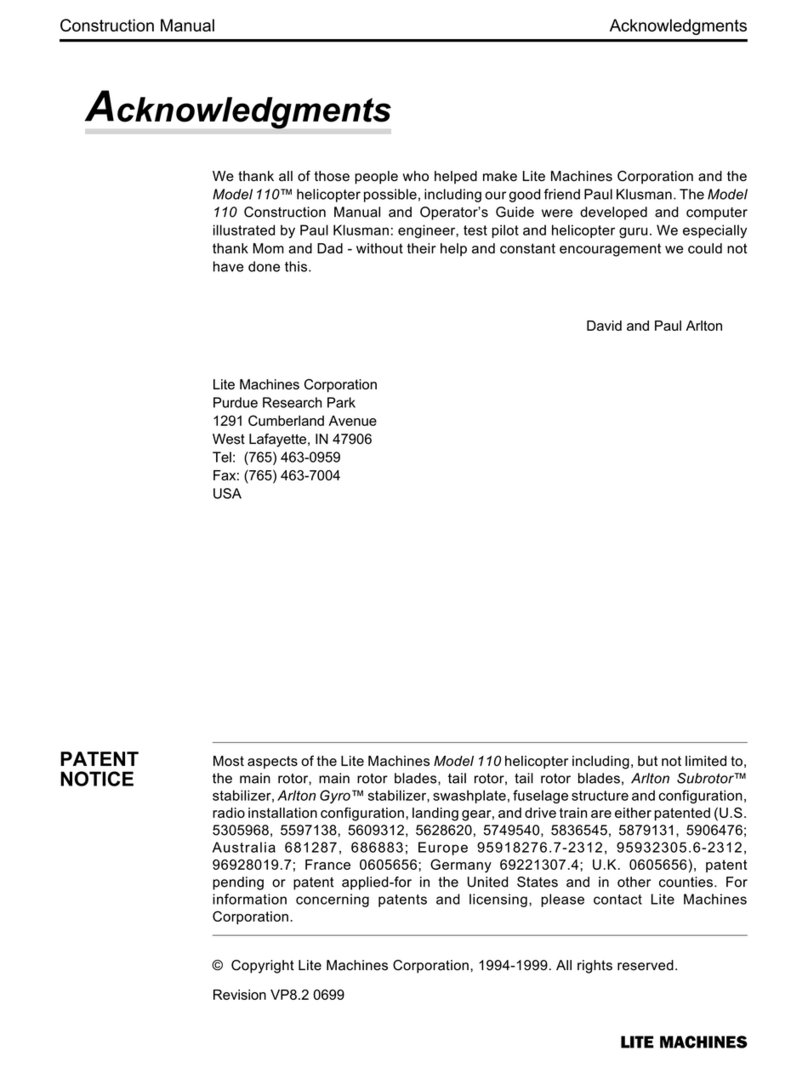
Flight Safety
1. ALWAYS WEAR APPROPRIATE EYE PROTECTION WHEN OPERATING
YOURMODEL. Fueldroplets,looseparts,andairbornedebrisejectedfromyour
model could cause serious injury or blindness. Select comfortable, well-fitting
eyewearwithhigh-impactresistancesuchasshopglasses.Prescriptionglasses
made of glass are dangerous because they could shatter if struck sharply.
2. ALWAYSWEARAPPROPRIATEHEARINGPROTECTIONWHENSTARTING
AND ADJUSTING YOUR ENGINE. Many car, airplane and helicopter modelers
ignore the sound produced by the engines on their models. High volumes and
highfrequenciesproducedbymodelenginescandamagehearing.Thisdamage
can be cumulative. Ear-phone and ear-plug style hearing protectors (sold in
sporting goods stores in the gun section) are inexpensive and effective at
reducing the most damaging and annoying qualities of engine sound. Once your
model is started and flying, hearing protection is usually not necessary.
3. NEVERSTANDOR PLACEYOUR EYES ORFACE IN-LINE WITHROTATING
MAINROTORORTAILROTORBLADES.Loosepartsordebristhrownoutward
from rotating rotors could cause injury or blindness.
4. NEVER, EVER FLY NEAR OR OVER PEOPLE. Always keep your model at a
safe distance from yourself and spectators.
5. Use only those model engines designed specifically for your Lite Machines
helicopter. Use of more powerful engines (such as racing engines) is potentially
dangerous and voids all warranties.
6. Do not use fuel containing more than 35% nitromethane. The added power and
heat of high nitro fuels can damage both the engine and your model.
7. Never allow main rotor speed to exceed 2000 RPM (as by operating with blade
pitchsettoolow,orusing ahighpowered enginewithhigh nitrofuel).Rotor parts
couldseparate fromtherotorheadandcauseserious injuryorpropertydamage.
Very high speeds can also damage the engine.
8. Flyonlyatapprovedflyingfieldsorinopenareasawayfrompeopleandproperty.
Do not fly in residential areas.
9. Before turning on your radio, ensure that your radio frequency is not already in
use. Flying clubs have organized frequency sharing procedures.
10. Range check your radio prior to the first flight of each day. If your range check is
lower than normal, do not fly.
11. Priortothefirstflightof each day, check all mechanics for smooth, unobstructed
operation. Before the main rotors reach flying speed, gently move all flight
controlsandconfirmproperfunction.Donotflyifanythingisoutoftheordinary.
12. Check for hidden damage after crashing, and replace any damaged
components.
13. Beginners should have the main rotors tracked, and model adjusted for flight by
an experienced modeler.
Operator's Guide Model Helicopter Safety
1-2LITE MACHINES






























